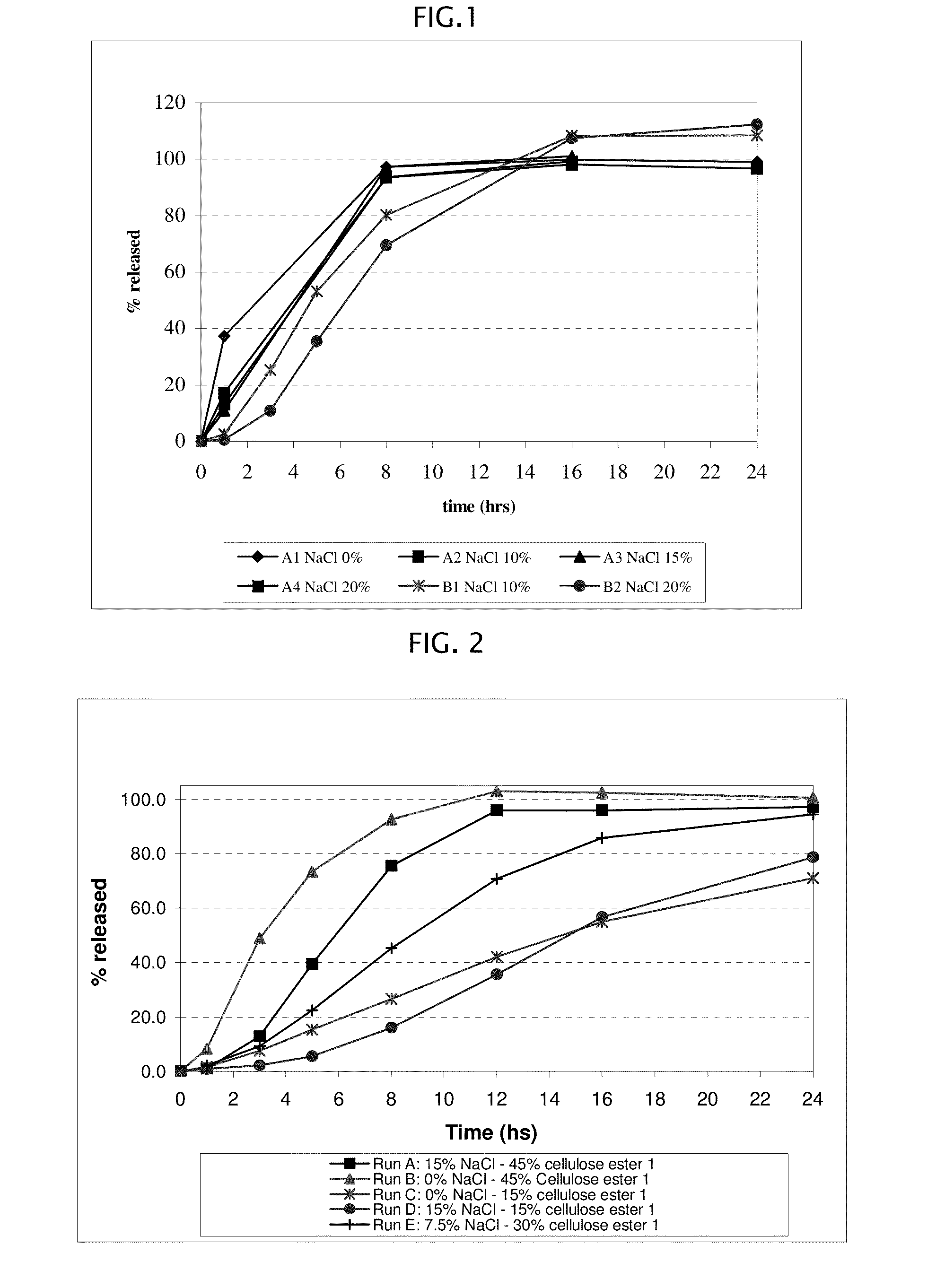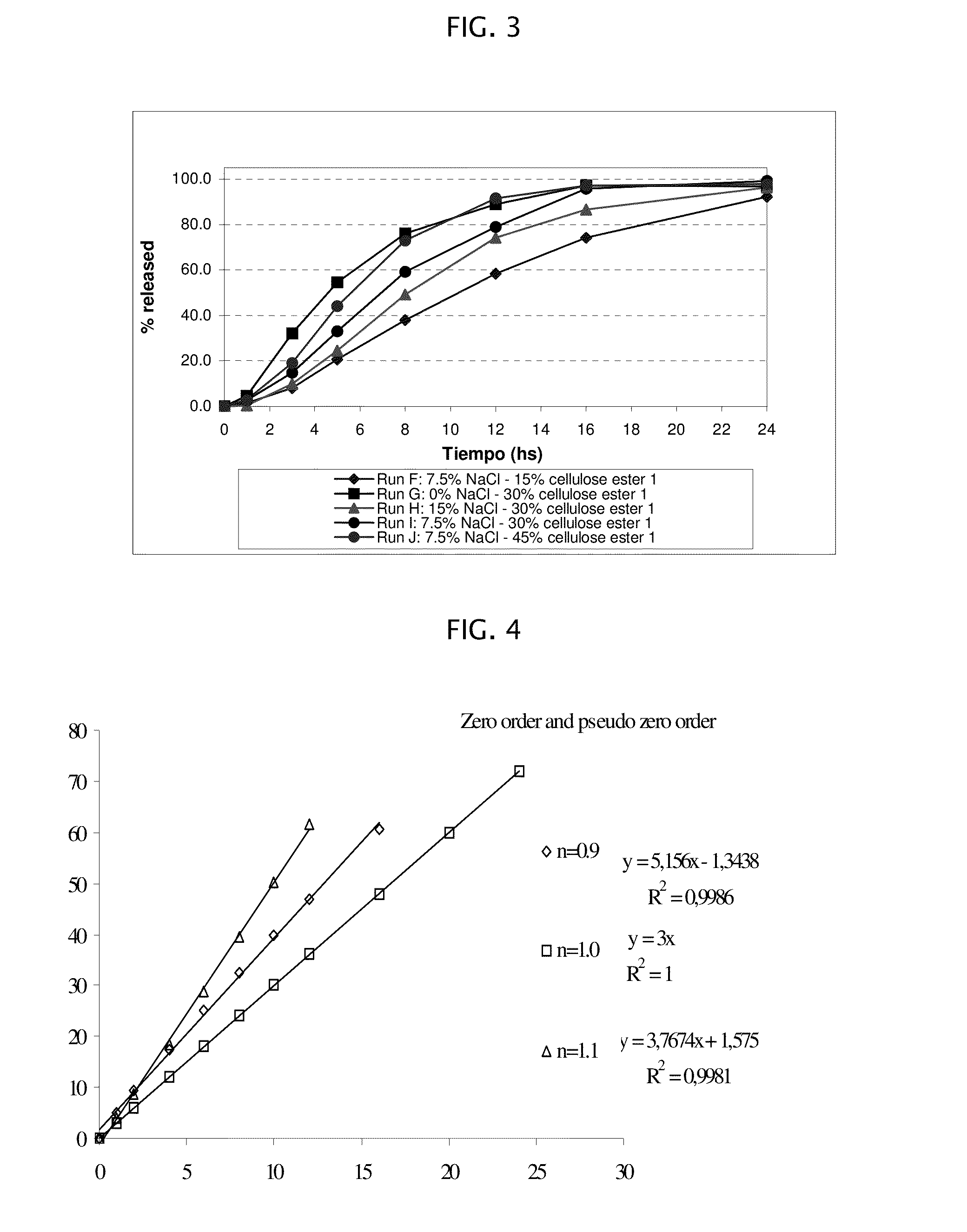Osmotic Device Containing Amantadine and an Osmotic Salt
a technology of amantadine and osmotic salt, which is applied in the direction of biocide, heterocyclic compound active ingredients, peptide/protein ingredients, etc., can solve the problems of premature release of drugs, more difficult formulation of high-soluble drug salts into osmotic devices, and difficult to achieve the effect of reducing the rate of amantadine releas
- Summary
- Abstract
- Description
- Claims
- Application Information
AI Technical Summary
Benefits of technology
Problems solved by technology
Method used
Image
Examples
example 1
[0178]Amantadine HCl osmotic device tablets of 200 mg strengths comprising coating A, and 0, 10, 15 and 20% of sodium chloride in the core, and amantadine HCl osmotic device tablets of 200 mg strengths comprising coating B and 10, and 20% of sodium chloride in the core were manufactured with the following general method. Amantadine hydrochloride (200 mg), a diluent (70-200 mg), and a binder (18-30 mg), were first individually screened to a uniform size using a Quadro Comil at less than 1,000 rpm, and then mixed with sodium chloride previously milled using a Fitz Mill with a screen 0020-0069 at less than 8000 rpm, in a mixer granulator for up to 25 minutes to form a homogenous powder blend. The granulation process was initiated by the gradual addition of purified water to the powder blend, with continuous mixing, to change the consistency of the dry powder ingredients to granules. The wet granulation was sieved through a Quadro Comil at a speed less than 1000 rpm, and then dried in a...
example 2
[0182]Amantadine HCl osmotic device tablets of 300 mg strengths were manufactured as described herein. The osmotic device tablets contain the following ingredients in the amounts indicated:
IngredientsAmount (mg)CoreAmantadine HCl300Diluent 1 20-110Binder15-30Glidant0.2-5 Lubricant1-7Sodium Chloride 0-150Diluent 220-60Osmopolymer 0-45CoatingCellulose ester 1 0-50Cellulose ester 2 0-50Plasticizer0.5-3.0
[0183]Amantadine hydrochloride (300 mg), diluent 1 (20-110 mg), diluent 2 (20-60 mg), a binder (15-30 mg), and an Osmopolymer (0-45 mg) were first individually screened to a uniform size using a Quadro Comil at less than 500 rpm, and then mixed with sodium chloride (0-150 mg) previously milled using a Fitz Mill with a screen 0020-0069 at less than 8000 rpm, in a mixer granulator for up to 5 minutes to form a homogenous powder blend. The granulation process was initiated by the gradual addition of purified water to the powder blend, with continuous mixing, to change the consistency of t...
example 3
[0186]The osmotic device tablets of examples 1 or 2 containing citalopram HBr (5, 10 and 20 mg strength) in a drug-containing external coat are prepared following the general procedure. Citalopram hydrobromide, a film forming polymer, a disintegrant and plasticizer are added to the purified water to form the coating suspension. This suspension is sprayed onto the tablets in a perforated pan coater to obtain drug load coated tablets.
[0187]A finish coat comprising Opadry in purified water is applied onto the drug load coated tablets to obtain the amantadine controlled release-citalopram immediate release osmotic device tablets.
PUM
| Property | Measurement | Unit |
|---|---|---|
| solubility | aaaaa | aaaaa |
| lag time | aaaaa | aaaaa |
| weight ratio | aaaaa | aaaaa |
Abstract
Description
Claims
Application Information
 Login to View More
Login to View More - R&D
- Intellectual Property
- Life Sciences
- Materials
- Tech Scout
- Unparalleled Data Quality
- Higher Quality Content
- 60% Fewer Hallucinations
Browse by: Latest US Patents, China's latest patents, Technical Efficacy Thesaurus, Application Domain, Technology Topic, Popular Technical Reports.
© 2025 PatSnap. All rights reserved.Legal|Privacy policy|Modern Slavery Act Transparency Statement|Sitemap|About US| Contact US: help@patsnap.com



